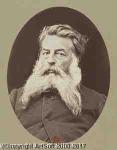Jean Louis Ernest Meissonier
Ernest Meissonier;Jean Louis Ernest Meissonier
Style: Academicism;
Place: Lyon
Born: 1815
Death: 1891
Biography:
Early Life and Training
Jean-Louis Ernest Meissonier, a renowned French painter and sculptor, was born on February 21, 1815, in Lyon, France. His father, Charles, expected him to follow in his footsteps as a successful businessman, but Meissonier's passion for painting prevailed. At the age of seventeen, he obtained permission from his parents to pursue an artistic career. Meissonier's early training included studying under Léon Cogniet and being influenced by Dutch masters at the Louvre. This foundation would later shape his distinctive style.
Rise to Prominence
Meissonier's breakthrough came with his painting Les Bourgeois Flamands (Dutch Burghers), also known as The Visit to the Burgomaster, exhibited at the Salon of 1831. This work, now part of Sir Richard Wallace's collection at Hertford House in London, marked the beginning of Meissonier's success with microscopic painting miniature in oils.
- Meissonier's subsequent works, such as The Game of Chess (1841), The Young Man playing the 'Cello (1842), and Painter in his Studio (1843), solidified his reputation for meticulous craftsmanship.
- His marriage to Emma Steinhel, a Protestant woman from Strasbourg, in 1838, marked a significant personal milestone.
- Meissonier's involvement with the National Guard during the June Days of 1848 showcased his commitment to the republican government.
Legacy and Notable Works
Meissonier is often referred to as the French Metsu, a nod to the Dutch painter Gabriel Metsu, known for his miniature scenes of bourgeois domestic life. Meissonier's works, characterized by their microscopic detail, include:
- Halt at an Inn, owned by the Duc de Morny.
- The Brawl, owned by Queen Victoria.
- The Gamblers and The Quarrel (La Rixe), presented to the English Court by Napoleon III.
Meissonier's later work, The Emperor at Solferino, a battle scene depicting Napoleon III, marked a departure from his typical genre.
Museums and Collections
Meissonier's works can be found in various museums, including the Musée d'Orsay in Paris. To explore more of Meissonier's art, visit [https://Wikioo.org/@/Jean-Louis-Ernest-Meissonier](https://Wikioo.org) and discover the masterpieces at [Musée d'Orsay](https://en.wikipedia.org/wiki/Mus%C3%A9_d%27Orsay).
- Learn more about Meissonier's life and works on [Wikipedia](https://en.wikipedia.org/wiki/Ernest_Meissonier).
- Explore the Musée d'Orsay's collection at [Musée d'Orsay Official Website](https://en.wikipedia.org/wiki/Mus%C3%A9_d%27Orsay).
Conclusion
Jean-Louis Ernest Meissonier, a master of French Classicism, left an indelible mark on the art world with his meticulous and detailed works. His legacy continues to inspire artists and art enthusiasts alike, offering a glimpse into 19th-century France's rich cultural heritage.
Wikipedia link: Click Here














